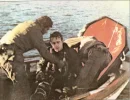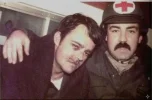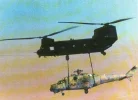In January 1991, Both Iraq and America Claimed Fictional Air-to-Air Victories
No, a U.S. EF-111 didn't force an Iraqi Mirage to crash
WIB airWIB history September 28, 2017
Tom Cooper
During the U.S.-led air war on Iraq in 1991, a U.S. Air Force EF-111A electronic-warfare plane forced an Iraqi air force Mirage F.1EQ to fly into the ground. The EF-111 thus scored an air-to-air kill without ever firing a shot.
At least, that’s what the U.S. Air Force claimed. For their part, the Iraqis believed the Mirage pilot had shot down the EF-111. In fact, both the Iraqi and American plane survived the encounter — and no one scored any kill at all that night.
The story began shortly after 3:00 in the morning, local time, on Jan. 17. A formation of 21 U.S. Air Force F-15Es entered Iraqi air space on a mission to bomb 26 fixed Scud missile launchers within a complex of airfields in western Iraq known in the West as “H-2” and “H-3.”
Two EF-111 stand-off jammers, variants of the F-111 bomber, supported the F-15s by scrambling the radars that guided Iraq’s surface-to-air missiles.
Well behind these 23 fighters, and just south of the Saudi border, three squadrons of F-15C fighters were airborne. Their task was to wait for the F-15Es to begin their exits, before sweeping into Iraqi airspace to attack any enemy interceptors pursuing the egressing fighter-bombers.
The U.S. formation was under the control of an E-3A radar plane flying over northwestern Saudi Arabia. This initially tracked four radar contacts over Iraq, arrayed in a wide arc from Ar Rutbah to Habbaniyah.
Due to their ingress at a very low altitude, and activity of the two EF-111s, the F-15Es remained undetected by the Iraqi early warning radars until their bombs began exploding on the Scud sites at 3:05. Correspondingly, not one of Iraqi fighters that was airborne reacted to them.
At top — an EF-111A in flight in 1980s. Albert Grandolini Collection. Above — Mirage F.1EQ serial number 4021 – the aircraft flown by Jabouri during his encounter with an EF-111A, on Jan. 17, 1991 – as seen before delivery to Iraq. Albert Grandolini Collection
Things changed about a minute later when, alerted by attack on Scud launched sites, Iraqi ground control scrambled a single Mirage F.1EQ from Sa’ad air base, better known in the West as “H-2.”
The Iraqi fighter in question bore the serial number 4021, and was flown by Capt. Nafie Najim Al Jabouri, from No. 79 Squadron of the Iraqi air force. Jabouri was a veteran fighter pilot. Graduating as one of the best in his class from the Helenic Air Force Academy in 1986, he accumulated nearly 1,000 hours on Mirage F.1s during the war with Iran.
While flying in a northwestern direction, Jabouri saw flashes from the F-15s’ bombs. He spotted a number of unknown aircraft in the sky around him, and plenty of white contrails from SAMs.
At around 3:20, a target appeared on his radar screen, and Jabouri requested permission from his ground controller to open fire. Permission granted, the Iraqi locked-on a single Matra Super 530F-1 semi-active radar homing air-to-air missile at a range of around 10 kilometers.
He was targeting an EF-111 flown by Capt. James Denton. Capt. Brent Brandon was the electronic warfare officer. Unaware of the presence of an Iraqi Mirage, Denton and Brandon were taken by surprise when their radar warning gear alerted them they were under fire.
Denton flew abrupt defensive maneuvers while Brandon released chaff and activated electronic countermeasures. Decoyed by the stream of flares, the French-made air-to-air missile missed. It detonated before actually reaching its target.
Behind them, Jabouri lost the lock on on the EF-111 around the same time his missile was supposed to hit the target. He concluded he’d scored a kill. Nevertheless, he continued in the same direction for a few seconds longer.
One of last official photographs of Nafie Najim Al Jabouri, taken shortly before the U.S. invasion in 2003. Photo via Ali Tobchi
To the U.S. crew, it thus appeared as if the Mirage continued to pursue them. Certainly enough, Jabouri’s radar was still emitting and thus “painted” the American aircraft. Denton threw the EF-111 into an evasive maneuver, while Brandon released another stream of flares.
When even this proved insufficient to shake off the Mirage, the U.S. pilot decided to descend to the safest possible altitude, then suddenly accelerate up and away. As the EF-111 approached the rocky desert ground of western Iraq, on Brandon’s instruction Denton suddenly pulled on the stick, while simultaneously ramming the throttles forward.
The EF-111 jumped into a climb, accelerating to supersonic speed.
A second later, there was a flash in the darkness behind them. Apparently, the Mirage had hit the ground and disappeared in a giant ball of fire.
Actually, Jabouri had turned away. He was briefly detected by one of the F-15Cs that was speeding north from the Saudi border and thus decided to disengage before it was too late. Flying at maximum speed and very low level, he evaded his pursuer and returned safely to Sa’ad.
When the smoke of this and following air battles cleared, both sides claimed a kill.
In February 1991, the U.S. Air Force wrote off the EF-111 that had been involved in the January engagement. EF-111 serial number 66-0023 crashed on the Iraq-Saudi Arabia border. The Iraqis took the write-off to mean that, in fact, Jabouri had shot down the plane. Baghdad credited the pilot with a confirmed kill.
Denton and Brandon were not only never shot down, they were credited with flying a Mirage F.1 into the ground and decorated with the Distinguished Flying Cross for their action.
Nafie Najim Al Jabouri continued flying Mirages with the Iraqi air force for the following 12 years. He was killed in March 2003 while attempting to take off from a makeshift runway for the only combat sortie the Iraqi air force launched in response to the U.S. invasion of Iraq.
Brig. Gen. Ahmad Sadik assisted with this article, which appeared in part in International Air Power Review, Vol. 26
, in 2009.









